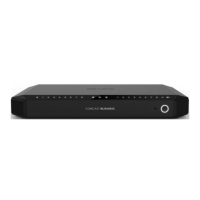
Do you have a question about the Technicolor CGA4131COM and is the answer not in the manual?
| Type | Wireless Router |
|---|---|
| Frequency Bands | 2.4 GHz, 5 GHz |
| Ethernet Ports | 4 |
| WAN Port | 1 |
| USB Ports | 1 |
| Weight | 500g |
| DOCSIS | 3.0 |
| Wireless Standard | 802.11ac |
| Security | WPA2 |
Details restrictions on disassembling, copying, modifying, or distributing the equipment.
Covers general safety precautions, climatic conditions, cleaning, water and moisture, handling batteries, and interface classifications.
Discusses compliance with FCC rules, North American regulations, and interference statements.
Explains symbols used in the manual for danger, warning, caution, and note.
Details text formatting conventions like hyperlinks, internal links, and GUI elements.
Provides an overview of the Gateway's main features, including DOCSIS, Ethernet, Wi-Fi, and FXS ports.
Introduces the different physical components of the Gateway, including front, top, back, and bottom panels.
Outlines local connection requirements for wireless and wired setups before starting the installation.
Guides users on connecting the Gateway to their service provider's network using a coaxial cable.
Details the procedure for powering on the Gateway using the provided power cord and connecting it to an electrical outlet.
Explains how to connect wired devices like computers and printers using Ethernet cables to the Gateway's ports.
Describes how to connect wireless devices to the Gateway's 2.4 GHz and 5 GHz access points.
Guides users on connecting traditional phones, DECT base stations, or faxes to the Gateway's RJ-11 telephone jacks.
Identifies and explains the different sections and elements within the Gateway's Admin Tool interface.
Provides step-by-step instructions on changing the default administrator username and password for enhanced security.
Explains how to save the current Gateway configuration and how to restore it if needed.
Displays the current status of the connected battery, including power status, installation, and condition.
Guides users on configuring wireless network settings like SSID, security mode, channel, and password via the Admin Tool.
Explains how to add wireless clients using WPS Push Button Configuration or PIN entry through the Admin Tool.
Details how to set up MAC filtering to control which devices can access the wireless network.
Explains how to filter website access based on URLs, keywords, and manage trusted devices.
Allows blocking specific websites or keywords, and marking devices as trusted to bypass rules.
Enables creation of rules to block specific Internet services and allows marking devices as trusted.
Allows creating device-specific rules to prevent or allow network access based on device type or schedule.
Generates reports on parental control rule infringements and logs network activity.
Describes the integrated firewall and how to change its security level (Maximum, Typical, Minimum, Custom).
Covers configuring ports for applications and services, including UPnP, Port Forwarding, and Port Triggering.
Explains Universal Plug and Play for automating network setup and device discovery.
Details how to forward incoming Internet traffic on specific ports to internal IP addresses.
Describes dynamic port forwarding rules activated by outbound traffic on trigger ports.
Allows defining rules to restrict inbound traffic to specific computers on the True Static IP network.
Enables remote access to the Gateway for troubleshooting and maintenance via HTTP and HTTPS.
Allows configuring a local device as a De-Militarized Zone (DMZ) host, bypassing firewall rules.
Explains Network Address Translation (NAT) for managing 1-to-1 IP address mapping.
Allows manual addition of static routes to create specific paths to destined networks.
Configures the Gateway's router functionality as a Dynamic DNS client.
Guides on assigning a fixed IP address to devices for consistent network access.
Provides solutions for issues related to no wireless connectivity or poor wireless connectivity and range.
Introduces diagnostic tools available in the Admin Tool to test network connectivity.
Explains how to reset or restore the Gateway to its default settings via the Admin Tool or the reset button.